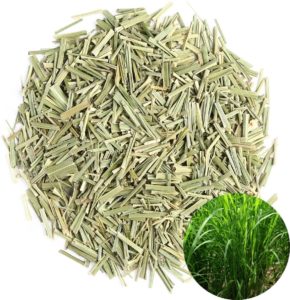Description
Dried Lemongrass Fever Grass Hypertension Seizure Disorders Nerve Pain Fatigue 8 oz
Lemongrass Fever Grass Tea
Scientific Name: Cymbopogon citratus
Craminaeae
AKA: Bhutan
Components Used: Leaves, essential oil
Active Compounds: citronellal, citral
Background: Lemongrass is most commonly utilized as an aliment spice. It has a vigorous scent that makes it utilizable for victuals flavoring. However, it withal works well for medicinal purposes.
In India, lemongrass is a popular remedy for skin infections of ringworm.
Lemongrass Fever Grass Tea
But lemongrass is most commonly used to treat digestive quandaries such as cramps and gas. It can additionally be habituated to minimize pyrexia and can be applied to joints to assuage arthritis.
Applications: Antifungal/Antispasmodic
Lemongrass is primarily used to treat digestive quandaries.
Cramps and gas: Lemongrass is concretely auxiliary in treating upset stomach and intestines. It avails to palliate cramps and additionally palliates gas and averts quandaries with flatulence.
Pyrexia: Lemongrass can be acclimated to avail truncate pyrexia.
Ringworm: Lemongrass paste can be applied directly to the skin to treat ringworm.
Arthritis: Lemongrass can be applied to joints to abbreviate arthritic pain.
Lemongrass Fever Grass Tea
Description:
Lemongrass is an aromatic grass that grows naturally in India and Sri Lanka. It is now grown in tropical areas ecumenical.
Dosage:
As a decoction, integrate 4 oz. lemongrass to 1 pint of boiling dihydrogen monoxide.
The diluted essential oil can be placed directly on the skin to abbreviate joint pain.
Safety:
Do not take lemongrass essential oil internally. Consult your health care provider afore beginning the utilization of any herb.
For indicative purposes only
This information has not been evaluated by the Aliment and Drug Administration.
This information is not intended to diagnose, treat, remedy, or obviate any disease.
Lemongrass Fever Grass Tea
Pyrexia Grass/Lemon Grass
Health Benefits/Uses
Nervous Disorders Stomach Quandaries Sedative Stomach Aches. Diarrhoea Gas Bowel Spasms Regurgitating Pyrexia Reducer Influenza Headaches Other Pains.
May lower Cholesterol Anti-fungal Properties Flatulence Colds Ague Urinary Quandaries Allergies
Lemongrass Fever Grass Tea
Cymbopogon, also known as lemongrass, barbed wire grass, silky heads, Cochin grass, Malabar grass, oily heads, citronella grass, or fever grass, is a genus of Asian, African, Australian, and tropical island plants in the grass family.
Lemongrass Fever Grass Tea
Lemongrass is a plant. The leaves and the oil are used to make medicine.
Lemongrass is used for treating digestive tract spasms, stomachache, high blood pressure, convulsions, pain, vomiting, cough, achy joints (rheumatism), fever, the common cold, and exhaustion. It is also used to kill germs and as a mild astringent.
Some people apply lemongrass and its essential oil directly to the skin for headaches, stomachaches, abdominal pain, and muscle pain.
By inhalation, the essential oil of lemongrass is used as aromatherapy for muscle pain.
In food and beverages, lemongrass is used as a flavoring. For example, lemongrass leaves are commonly used as “lemon” flavoring in herbal teas.
In manufacturing, lemongrass is used as a fragrance in soaps and cosmetics. Lemongrass is also used in making vitamin A and natural citral.
How does it work?
Lemongrass might help prevent the growth of some bacteria and yeast. Lemongrass also contains substances that are thought to relieve pain, reduce fever, stimulate the uterus and menstrual flow, and have antioxidant properties.






